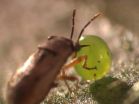Prion protein hints at role in aiding learning and memory
2012-10-16
(Press-News.org) Scientists from the University of Leeds have found that the protein called prion helps our brains to absorb zinc, which is believed to be crucial to our ability to learn and the wellbeing of our memory.
The findings published today (Tuesday 16 October) in Nature Communications show that prion protein regulates the amount of zinc in the brain by helping cells absorb it through channels in the cell surface. It is already known that high levels of zinc between brain cells are linked with diseases such as Alzheimer's and Parkinson's.
Professor Nigel Hooper from the University's Faculty of Biological Sciences explains: "With ageing, the level of prion protein in our brains falls and less zinc is absorbed by brain cells, which could explain why our memory and learning capabilities change as we get older. By studying both their roles in the body, we hope to uncover exactly how prion and zinc affect memory and learning. This could help us better understand how to maintain healthy brain cells and limit the effects of ageing on the brain."
Whilst the abnormal infectious form of prion - which causes Creutzfeldt-Jakob disease (CJD) in humans and bovine spongiform encephalopathy (BSE) in cattle - has been extensively studied, the Leeds team is among the first to investigate the role of the 'normal' form of the protein.
Lead researcher, Dr Nicole Watts, says: "Zinc is thought to aid signalling in the brain as it's released into the space between brain cells. However, when there's too much zinc between the brain cells it can become toxic. High levels of zinc in this area between the brain cells are known to be a factor in neurodegenerative diseases, so regulating the amount of absorption by the cells is crucial."
The research, funded by the Medical Research Council, Wellcome Trust and Alzheimer's Research UK, may have implications for how we treat – and possibly prevent – neurodegenerative diseases in the future.
Dr Simon Ridley, Head of Research at Alzheimer's Research UK, said: "We're pleased to have helped support this study, which has uncovered new information that could one day aid the development of new treatments for Alzheimer's. One next step would be to understand how regulating zinc levels may affect the progress of the disease. Results like these have the potential to lead to new and effective treatments – but for that to happen, we must build on these results and continue investing in research."
INFORMATION: END
ELSE PRESS RELEASES FROM THIS DATE:
2012-10-16
(Edmonton) Northern Alberta's boreal forest shows a surprising resiliency to human intrusion, but University of Alberta researchers warn the landscape has a definite breaking point.
The U of A research team led by graduate student Stephen Mayor found that up to a certain point plant life in the boreal forest responded to intrusions such as roadways and farm fields by actually increasing its biodiversity.
The researchers, counted plant species in sites across the whole of northern Alberta, an area larger than Germany. Then satellite and aerial photos were used to ...
2012-10-16
Volcanic eruptions vary from common, small eruptions that have little impact on humans and the environment to rare, large-to-gigantic eruptions so massive they can threaten civilizations.
While scientists don't yet fully understand the mechanisms that control whether an eruption is large or small, they do know that eruptions are driven by the rapid expansion of bubbles formed from water and other volatile substances trapped in molten rock as it rises beneath a volcano. The mechanism is much the same as that involved in shaking a bottle of a carbonated drink and then ...
2012-10-16
Tampa, FL (Oct. 16, 2012) -- A landmark paper identifying genetic signatures that predict which patients will respond to a life-saving drug for treating congestive heart failure has been published by a research team co-led by Stephen B. Liggett, MD, of the University of South Florida.
The study, drawing upon a randomized placebo-controlled trial for the beta blocker bucindolol, apprears this month in the online international journal PLoS ONE. In addition to Dr. Liggett, whose laboratory discovered and characterized the two genetic variations, Christopher O'Connor, ...
2012-10-16
This press release is available in German.
To solve the acute, global problem of securing food resources for a continuously growing population, we must work constantly to increase the sustainability and effectiveness of modern agricultural techniques. These efforts depend on new insights from plant ecology, particularly from work on native plants that grow in the primordial agricultural niche. Based on field studies on wild tobacco plants in the Great Basin Desert, Utah, USA, researchers of the Max Planck Institute for Chemical Ecology in Jena, Germany, demonstrated that ...
2012-10-16
An extremely brief reversal of the geomagnetic field, climate variability and a super volcano
41,000 years ago, a complete and rapid reversal of the geomagnetic field occured. Magnetic studies of the GFZ German Research Centre for Geosciences on sediment cores from the Black Sea show that during this period, during the last ice age, a compass at the Black Sea would have pointed to the south instead of north. Moreover, data obtained by the research team formed around GFZ researchers Dr. Norbert Nowaczyk and Prof. Helge Arz, together with additional data from other studies ...
2012-10-16
People in creative professions are treated more often for mental illness than the general population, there being a particularly salient connection between writing and schizophrenia. This according to researchers at Karolinska Institutet in Sweden, whose large-scale registry study is the most comprehensive ever in its field.
Last year, the team showed that artists and scientists were more common amongst families where bipolar disorder and schizophrenia is present, compared to the population at large. They subsequently expanded their study to many more psychiatric diagnoses ...
2012-10-16
While studying Parkinson's disease, an international research group made a discovery which can improve industrial protein synthesis for therapeutic use. They managed to understand a novel function of non-protein coding RNA: the protein synthesis activity of coding genes can be enhanced by the activity of the non-coding one called "antisense."
To synthesize proteins, the DNA needs RNA molecules serving as short "transcriptions" of the genetic information. The set of all these RNA molecules is called "transcriptome." In the human transcriptome, along with around 25 thousand ...
2012-10-16
Evolution has not only controlled human development over millions of years, it also has an impact on modern man. This is one of the conclusions of a study of Argentinian villagers in the Andes, where the water contains high levels of arsenic. A gene variant that produces efficient and less toxic metabolism of arsenic in the body was much more common among the villagers than among other indigenous groups in South or Central America. The study was a collaborative effort by Karin Broberg from Lund University and Carina Schlebusch and Mattias Jakobsson from Uppsala University ...
2012-10-16
Astronomers using the NASA/ESA Hubble Space Telescope have studied a giant filament of dark matter in 3D for the first time. Extending 60 million light-years from one of the most massive galaxy clusters known, the filament is part of the cosmic web that constitutes the large-scale structure of the Universe, and is a leftover of the very first moments after the Big Bang. If the high mass measured for the filament is representative of the rest of the Universe, then these structures may contain more than half of all the mass in the Universe.
The theory of the Big Bang predicts ...
2012-10-16
Dusty plasmas can be found in many places both in space and in the laboratory. Due to their special properties, dust acoustic waves can propagate inside these plasmas like sound waves in air, and can be studied with the naked eye or with standard video cameras. The RUB physicists Prof. Dr. Dr. h.c. Padma Kant Shukla and Dr. Bengt Eliasson from the Faculty of Physics and Astronomy have published a model with which they describe how large amplitude dust acoustic waves in dusty plasmas behave. The researchers report their new findings in the journal Physical Review E.
Different ...
LAST 30 PRESS RELEASES:
[Press-News.org] Prion protein hints at role in aiding learning and memory


